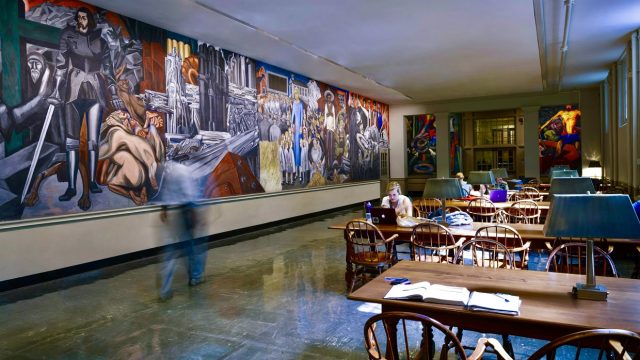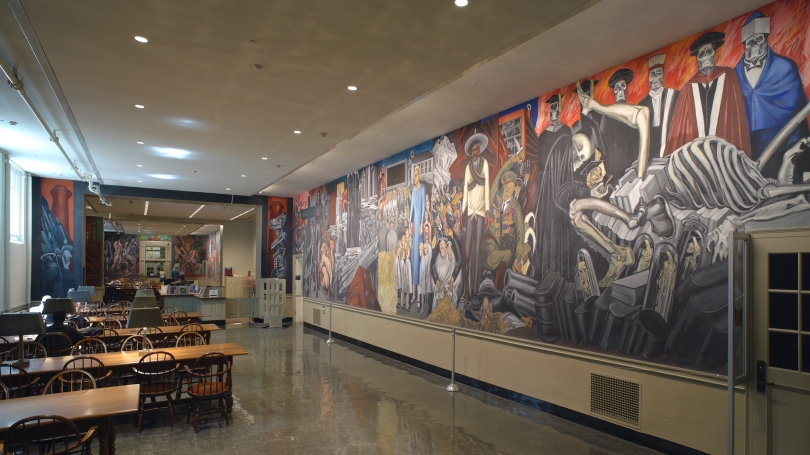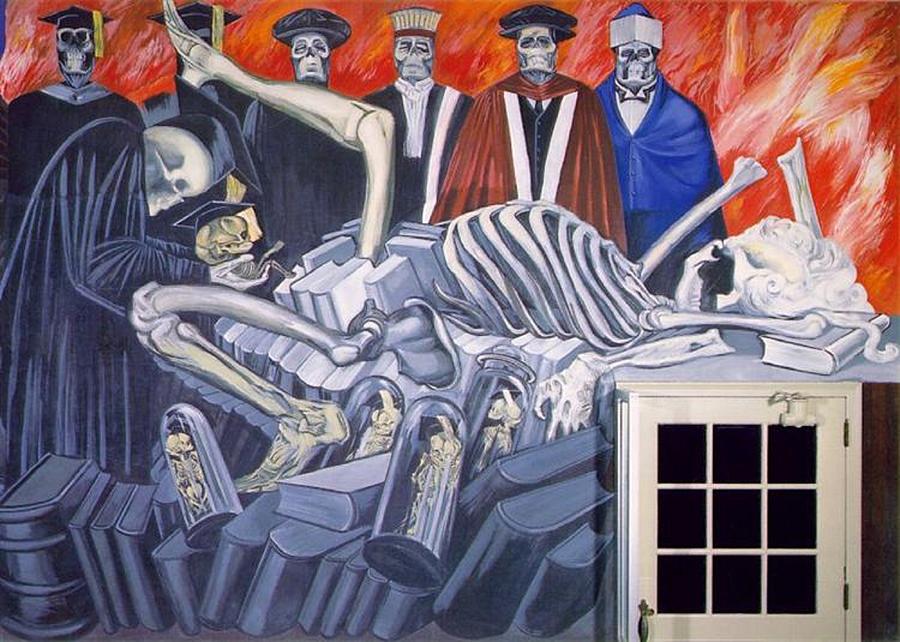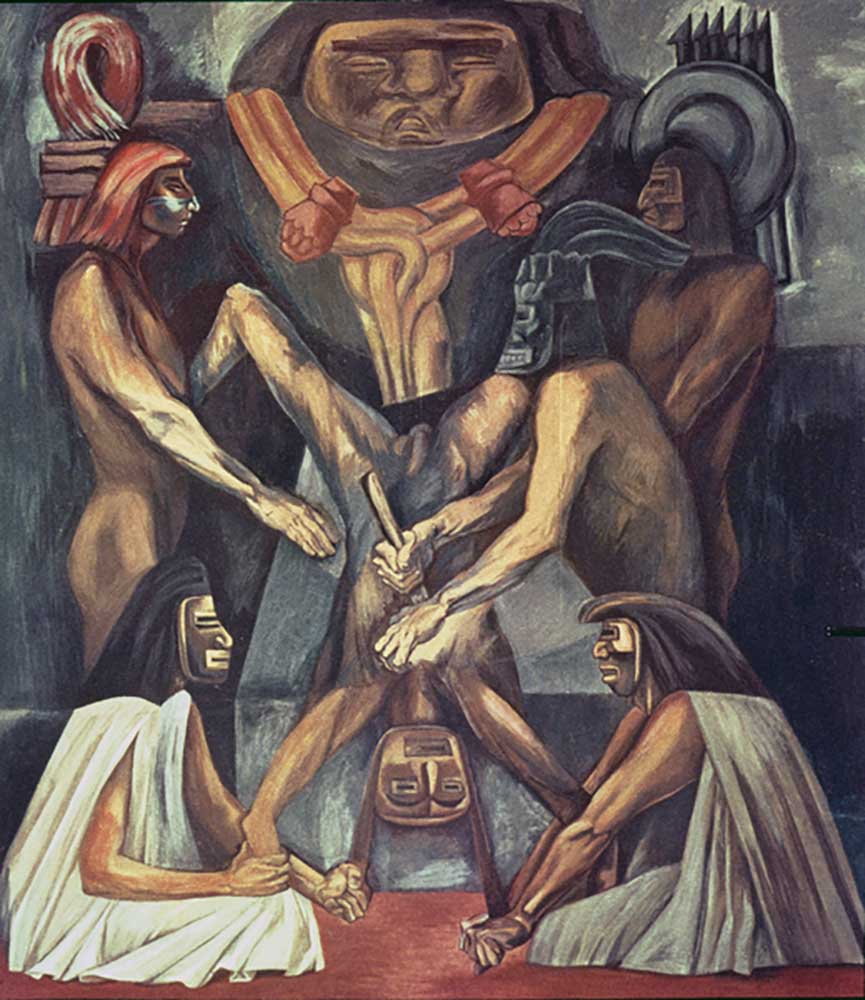I grew up in not-quite-nowhere, the kind of small town with a little shop or two, a post office, and a library that people think of when they watch Our Town. (In fact, we put the show on when I was in high school.) We’re smaller than a Hallmark movie “small town,” but just a little bigger than some of the surrounding villages. Spring means the smell of manure on the fields as much as the reappearance of green grass.
But I also grew up less than an hour from an Ivy League school: Dartmouth College and its affiliated medical school, which meant that students at our little not-quite-nowhere school qualified to pile into the bus to Hanover, New Hampshire for various subsidized enrichment activities. I distinctly remember learning to weave and make paper.
During at least one of these trips, which were focused on introducing us to Art, we were herded to the ground floor of what was then called Baker Library to see The Epic of American Civilization. You might think it would have blown our tiny minds, and it probably should have, but I mostly remember it as just one more of the many wonders an average trip to the college entailed in those days. It wasn’t like they let me paint my own mural; I couldn’t take it home like my freshly made paper.
Not to say that it wasn’t a wonder. Just to say that, as (mostly) white kids who grew up in an era dominated by a narrative of racial progress, we didn’t really have the tools to put those murals into perspective. We were impressed by the graphic violence, the unfamiliar style, and honestly, probably just by the thought of those giant paintings dominating a library, which we normally thought of as a pretty quiet environment (and Baker Library is, in fact, a pretty quiet environment). It was only when I was older — middle or high school — that we learned how radical the murals had really been.
On the outside, The Baker-Berry Library looks staid and formal, the kind of thing you’d imagine being built a century or two ago. It was modeled after Philadelphia’s Independence Hall, the impressive Georgian building that hosted the adoption of the Declaration of Independence and Constitution. As you walk in, there’s rich wood, some tasteful gold accents, and the general feel of a university library (which, after all, it is). The murals are just past the vestibule, on the ground floor. They are huge, colorful and stunning, and their artistic and historical significance means that in the pre-COVID days there were usually a few non-students milling around the space, phones or helpful pamphlets in hand, taking in the art.
There’s a lot to take in. According to Dartmouth’s own accounting of the project, the main advocates wanted José Clemente Orozco for the mural, and had to persuade the funders to go with him rather than the more famous Diego Rivera. Orozco came and painted a smaller piece for them in 1932, Man Released from the Mechanistic to the Creative Life, and between that and the plans he outlined for an ambitious, epic work, the funders were convinced and the mural commissioned. Orozco was given eighteen months and about $7,000 to transform the walls into ancient and modern myth. It would be Orozco’s own history of the Americas, surrounding the library with his vision.
Dartmouth was excited for the project; the sheer scope of it alone must have been thrilling. They were perhaps less prepared for what Orozco actually did.
He certainly takes on Mexican history, from the pre-Columbian era on, but he also takes some cracks at his hosts, both in the general — the scary white schoolmarm and her near-identical charges, the neglected unknown soldier’s tomb covered in empty symbolism — and the specific. I’ll quote directly from Dartmouth’s own brochure about the “Gods of the Modern World” panel: “In this savage and satirical denunciation of modern institutional education and its indifference to the political turmoil of the 1930s, Orozco portrays skeletons dressed in academic garb presiding over the birth of useless knowledge, embodied by the skeletal fetus.” (I will again return you to elementary school me, gazing up at a skeleton, surrounded by skeletons in caps and gowns, giving birth to a skeleton baby. I might not have known what it meant, but it sure was interesting to look at.)
It’s hard to give the full effect of these murals from behind a keyboard. Part of the impact of the work is seeing how Orozco worked in parallels, letting panels reflect and comment on one another, even from all the way across the room (Ancient Human Sacrifice, depicting a pre-Columbian ritual, and Modern Human Sacrifice are the most obvious of these, but there are many such connections, and they’re much easier to spot in a three-dimensional space. You could write a dozen essays on the use of steel girders or crosses, and the mural starts with men walking away from the viewer and ends with one man staring directly at you — and also at that first image, all the way down at the other end of the room.)
Orozco painted directly on the walls, and the mural’s colors have remained vibrant, a riot of color and expression looming over the traditional wooden shelving and thick, glossy tables that still furnish the library proper. You could look down at where some suffering undergraduate carved his initials, and back up to a man getting his heart carved out, moving backward and forward in time, from the ancient past to Orozco’s time to your own. (You’ll see dozens of computers in the reserve room now. I’m not sure there was a single one on the floor when I first visited the building, and laptops didn’t exist. Orozco painted his work to last, but there was no way he could have anticipated all the changes that were to come.)
I did some art history and aesthetics in college, but I’m going to leave the actual analysis to greater minds than mine. I’m just here to tell you that for three years in the 1930s, a Mexican artist created something that would echo for generations, even in the heads of small-town elementary school children.
Time had a good piece on the influence of Orozco, Rivera and David Alfaro Siqueiros.
The murals are on the National Register of Historic Places, and Dartmouth College has a good amount of information on their website about the murals, including putting them in more context than I do here. Take the 3-D tour!




